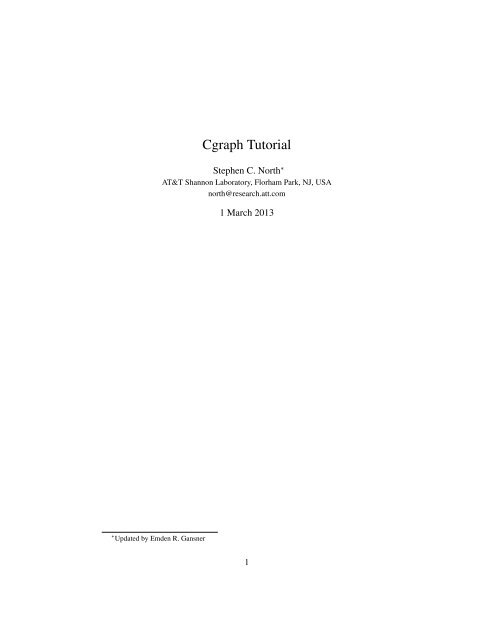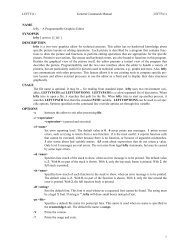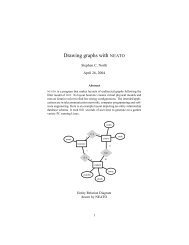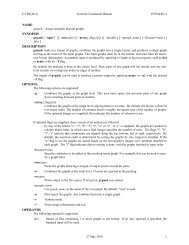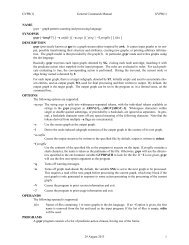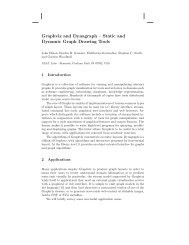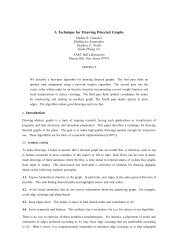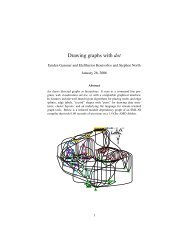Create successful ePaper yourself
Turn your PDF publications into a flip-book with our unique Google optimized e-Paper software.
Cgraph <strong>Tutorial</strong><br />
Stephen C. North ∗<br />
AT&T Shannon Laboratory, Florham Park, NJ, USA<br />
north@research.att.com<br />
1 March 2013<br />
∗ Updated by Emden R. Gansner<br />
1
Contents<br />
1 Introduction 3<br />
2 Graph Objects 3<br />
3 Graphs 4<br />
4 Nodes 5<br />
5 Edges 6<br />
6 Traversals 7<br />
7 External Attributes 8<br />
8 Internal Attributes 10<br />
9 Subgraphs 11<br />
10 Utility Functions and Macros 12<br />
11 Error Handling 13<br />
12 Strings 14<br />
13 Expert-level Tweaks 15<br />
13.1 Callbacks . . . . . . . . . . . . . . . . . . . . . . . . . . . . . . 15<br />
13.2 Disciplines . . . . . . . . . . . . . . . . . . . . . . . . . . . . . 16<br />
13.2.1 Memory management . . . . . . . . . . . . . . . . . . . 17<br />
13.2.2 I/O management . . . . . . . . . . . . . . . . . . . . . . 18<br />
13.2.3 ID management . . . . . . . . . . . . . . . . . . . . . . . 20<br />
13.3 Flattened node and edge lists . . . . . . . . . . . . . . . . . . . . 22<br />
14 Related Libraries 22<br />
15 Interfaces to Other Languages 23<br />
16 Open Issues 23<br />
17 Example 24<br />
2
1 Introduction<br />
Cgraph is a C library for graph programming. It defines data types and operations<br />
for graphs comprised of attributed nodes, edges and subgraphs. Attributes may<br />
be string name-value pairs for convenient file I/O, or internal C data structures for<br />
efficient algorithm implementation.<br />
Cgraph is aimed at graph representation; it is not an library of higher-level<br />
algorithms such as shortest path or network flow. We envision these as higherlevel<br />
libraries written on top of Cgraph. Efforts were made in Cgraph’s design to<br />
strive for time and space efficiency. The basic (unattributed) graph representation<br />
takes 104 bytes per node and 64 bytes per edge, so storage of graphs with millions<br />
of objects is reasonable. For attributed graphs, Cgraph also maintains an internal<br />
shared string pool, so if all the nodes of a graph have color=red, only one copy<br />
of "color" and "red" are made. There are other tricks that experts can exploit<br />
for flat-out coding efficiency. For example, there are ways to inline the instructions<br />
for edge list traversal and internal data structure access.<br />
Cgraph uses Phong Vo’s dictionary library, libcdt, to store node and edge sets.<br />
This library provides a uniform interface to hash tables and splay trees, and its API<br />
is usable for general programming (such as storing multisets, hash tables, lists and<br />
queues) in Cgraph programs.<br />
Notation In the following, we use TRUE to denote a non-zero value, and<br />
FALSE to denote zero.<br />
2 Graph Objects<br />
Almost all Cgraph programming can be done with pointers to these data types:<br />
• <strong>Agraph</strong>_t: a graph or subgraph<br />
• Agnode_t: a node from a particular graph or subgraph<br />
• Agedge_t: an edge from a particular graph or subgraph<br />
• Agsym_t: a descriptor for a string-value pair attribute<br />
• Agrec_t: an internal C data record attribute of a graph object<br />
Cgraph is responsible for its own memory management; allocation and deallocation<br />
of Cgraph data structures is always done through Cgraph calls.<br />
3
3 Graphs<br />
A top-level graph (also called a root graph) defines a universe of nodes, edges,<br />
subgraphs, data dictionaries and other information. A graph has a name and two<br />
properties: whether it is directed or undirected, and whether it is strict (multi-edges<br />
are forbidden). 1<br />
Note that nodes, edges and subgraphs exists in exactly one root graph. They<br />
cannot be used independently of that graph, or attached to another root graph.<br />
The following examples use the convention that G and g are <strong>Agraph</strong>_t*<br />
(graph pointers), n, u, v, w are Agnode_t* (node pointers), and e, f are Agedge_t*<br />
(edge pointers).<br />
To make a new, empty top-level directed graph:<br />
<strong>Agraph</strong>_t *g;<br />
g = agopen("G", Agdirected, NULL);<br />
The first argument to agopen is any string, and is not interpreted by Cgraph,<br />
except it is recorded and preserved when the graph is written as a file. 2 The second<br />
argument indicates the type of graph, and should be one of Agdirected,<br />
Agstrictdirected, Agundirected, or Agstrictundirected. The<br />
third argument is an optional pointer to a collection of methods for overriding certain<br />
default behaviors of Cgraph, and in most situations can just be NULL.<br />
You can get the name of a graph by agnameof(g), and you can get its properties<br />
by the predicate functions agisdirected(g) and agisstrict(g).<br />
You can also construct a new graph by reading a file:<br />
g = agread(stdin,NULL);<br />
Here, the graph’s name, type and contents including attributes depend on the<br />
file contents. (The second argument is the same optional method pointer mentioned<br />
above for agopen).<br />
Sometimes it is convenient to have the graph represented concretely as a character<br />
string str. In this case, the graph can be created using:<br />
g = agmemread (str);<br />
You can write a representation of a graph to a file:<br />
g = agwrite(g,stdout);<br />
1 It is possible to specify that a graph is simple (neither multi-edges nor loops), or can have multiedges<br />
but not loops.<br />
2 An application could, of course, maintain its own graph catalogue using graph names.<br />
4
agwrite creates an external representation of a graph’s contents and attributes<br />
(except for internal attributes), that can later be reconstructed by calling agread<br />
on the same file. 3<br />
agnnodes(g), agnedges(g) and agnsubg(g) return the count of nodes,<br />
edges and (immediate) subgraphs in a graph (or subgraph).<br />
To delete a graph and its associated data structures, freeing their memory, one<br />
uses:<br />
agclose(g);<br />
Finally, there is an interesting if obscure function to concatenate the contents<br />
of a graph file onto an existing graph, as shown here.<br />
g = agconcat(g,stdin,NULL);<br />
4 Nodes<br />
In Cgraph, a node is usually identified by a unique string name and a unique internal<br />
integer ID assigned by Cgraph. (For convenience, you can also create ”anonymous”<br />
nodes by giving NULL as the node name.) A node also has in- and out-edge<br />
sets, even in undirected graphs.<br />
Once you have a graph, you can create or search for nodes this way:<br />
Agnode_t *n;<br />
n = agnode(g,"node28",TRUE);<br />
The first argument is a graph or subgraph in which the node is to be created.<br />
The second is the name (or NULL for anonymous nodes.) When the third argument<br />
is TRUE, the node is created if it doesn’t already exist. When it’s FALSE, as<br />
shown below, then Cgraph searches to locate an existing node with the given name,<br />
returning NULL if none is found.<br />
n = agnode(g,"node28",FALSE);<br />
The function agdegree(g, n, in, out) gives the degree of a node in<br />
(sub)graph g, where in and out select the edge sets.<br />
• agdegree(g,n,TRUE,FALSE) returns the in-degree.<br />
3 It is the application programmer’s job to convert between internal attributes to external strings<br />
when graphs are read and written, if desired. This seemed better than inventing a complicated way<br />
to automate this conversion.<br />
5
• agdegree(g,n,FALSE,TRUE) returns the out-degree.<br />
• agdegree(g,n,TRUE,TRUE) returns their sum.<br />
The function agcountuniqedges is identical to agdegree except when the<br />
last two arguments are both TRUE. In this case, a loop is only counted once.<br />
agnameof(n) returns the printable string name of a node. Note that for<br />
various reasons this string may be a temporary buffer that can be overwritten by<br />
subsequent calls. Thus, the usage<br />
printf("%s %s\n",agnameof(agtail(e)),agnameof(aghead(e)));<br />
is unsafe because the buffer may be overwritten when the arguments to printf are<br />
being computed.<br />
A node can be deleted from a graph or subgraph by agdelnode(g,n).<br />
5 Edges<br />
An edge is a node pair: an ordered pair in a directed graph, unordered in an undirected<br />
graph. For convenience there is a common edge data structure for both kinds<br />
and the endpoints are the fields tail and head. 4<br />
Because an edge is implemented as an edge pair, there are two valid pointers to<br />
the same edge, so simple pointer comparison does not work for edge equality. The<br />
function Ageqedge(Agedge_t *e0, Agedge_t *e1) evaluates to true if<br />
the two pointers represent the same abstract edge.<br />
An edge is made using<br />
Agnode_t<br />
Agedge_t<br />
*u, *v;<br />
*e;<br />
/* assume u and v are already defined */<br />
e = agedge(g,u,v,"e28",TRUE);<br />
u and v must belong to the same graph or subgraph for the operation to succeed.<br />
The “name” of an edge (more correctly, identifier) is treated as a unique<br />
identifier for edges between a particular node pair. That is, there can only be at<br />
most one edge with name e28 between any given u and v, but there can be many<br />
other edges e28 between other nodes.<br />
head.<br />
4 When an edge is created, the first node will be used as the tail node, and the second node as the<br />
6
agtail(e) and aghead(e) return the endpoints of e. If e is created as in<br />
the call to agedge above, u will be the tail node and v will be the head node. This<br />
holds true even for undirected graphs.<br />
The value e->node is the “other” endpoint with respect to the node from<br />
which e was obtained. That is, if e is an out-edge of node n (equivalently, n is the<br />
tail of e), then e->node is the head of e. A common idiom is:<br />
for (e = agfstout(g,n); e; e = agnxtout(g,e))<br />
/* do something with e->node */<br />
agedge can also search for edges:<br />
/* finds any u,v edge */<br />
e = agedge(g,u,v,NULL,FALSE);<br />
/* finds a u,v edge with name "e8" */<br />
e = agedge(g,u,v,"e8",FALSE);<br />
In an undirected graph, an edge search will consider the given vertices as both<br />
tail and head nodes.<br />
An edge can be deleted from a graph or subgraph by agdeledge(g,e). The<br />
agnameof function can be used to get the “name” of an edge. Note that this will<br />
be the identifier string provided at edge creation. The names of the head and tail<br />
nodes will not be part of the string. In addition, it returns NULL for anonymous<br />
edges.<br />
6 Traversals<br />
Cgraph has functions for iterating over graph objects. For example, we can scan<br />
all the edges of a graph (directed or undirected) by the following:<br />
for (n = agfstnode(g); n; n = agnxtnode(g,n)) {<br />
for (e = agfstout(g,n); e; e = agnxtout(g,e)) {<br />
/* do something with e */<br />
}<br />
}<br />
The functions agfstin(g,n) and afnxtin(g,e) are provided for walking<br />
in-edge lists.<br />
In the case of a directed edge, the meanings of “in” and “out” are obvious. For<br />
undirected graphs, Cgraph assigns an orientation based on the analogous order of<br />
the two nodes when the edge is created.<br />
To visit all the edges of a node in an undirected graph:<br />
7
for (e = agfstedge(g,n); e; e = agnxtedge(g,e,n))<br />
/* do something with e */<br />
Be careful if your code deletes an edge or node during the traversal, as then the<br />
object will no longer be valid to get the next object. This is typically handled by<br />
code like:<br />
for (e = agfstedge(g,n); e; e = f) {<br />
f = agnxtedge(g,e,n))<br />
/* delete e */<br />
}<br />
Traversals are guaranteed to visit the nodes of a graph, or edges of a node, in<br />
their order of creation in the root graph (unless we allow programmers to override<br />
object ordering, as mentioned in section 16).<br />
7 External Attributes<br />
Graph objects may have associated string name-value pairs. When a graph file is<br />
read, Cgraph’s parser takes care of the details of this, so attributes can just be added<br />
anywhere in the file. In C programs, values must be declared before use.<br />
Cgraph assumes that all objects of a given kind (graphs/subgraphs, nodes, or<br />
edges) have the same attributes - there’s no notion of subtyping within attributes.<br />
Information about attributes is stored in data dictionaries. Each graph has three<br />
(for graphs/subgraphs, nodes, and edges) for which you’ll need the predefined constants<br />
AGRAPH, AGNODE and AGEDGE in calls to create, search and walk these<br />
dictionaries.<br />
Thus, to create an attribute for nodes, one uses:<br />
Agsym_t *sym;<br />
sym = agattr(g,AGNODE,"shape","box");<br />
If this succeeds, sym points to a descriptor for the newly created (or updated) attribute.<br />
(Thus, even if shape was previously declared and had some other default<br />
value, it would be set to box by the above.)<br />
By using a NULL pointer as the value, you can use the same function to search<br />
the attribute definitions of a graph.<br />
sym = agattr(g,AGNODE,"shape",0);<br />
if (sym)<br />
printf("The default shape is %s.\n",sym->defval);<br />
8
If you have the pointer to some graph object, you can also use the function agattrsym.<br />
Agnode_t* n;<br />
Agsym_t* sym = agattrsym (n,"shape");<br />
if (sym)<br />
printf("The default shape is %s.\n",sym->defval);<br />
Both functions return NULL if the attribute is not defined.<br />
Instead of looking for a particular attribute, it is possible to iterate over all of<br />
them:<br />
sym = 0; /* to get the first one */<br />
while (sym = agnxtattr(g,AGNODE,sym)<br />
printf("%s = %s\n",sym->name,sym->defval);<br />
Assuming an attribute already exists for some object, its value can be obtained<br />
or set using its string name or its Agsym_t descriptor. To use the string name, we<br />
have:<br />
str = agget(n,"shape");<br />
agset(n,"shape","hexagon");<br />
If an attribute will be referenced often, it is faster to use its descriptor as an<br />
index, as shown here:<br />
Agsym_t *sym = agattr(g,AGNODE,"shape","box");<br />
str = agxget(n,sym);<br />
agxset(n,sym,"hexagon");<br />
Cgraph provides two helper functions for dealing with attributes. The function<br />
agsafeset(void *obj, char *name, char *value, char *def)<br />
first checks that the attribute has been defined, defining it with the default value<br />
def if not. It then uses value as the specific value assigned to obj.<br />
It is sometimes useful to copy all of the values from one object to another. This<br />
can be easily done using agcopyattr(void *src, void* tgt). This assumes<br />
that the source and target are the same type of graph objects, and that the<br />
attributes of src have already been defined for tgt. If src and tgt belong to<br />
the same root graph, this will automatically be true.<br />
9
8 Internal Attributes<br />
It would be possible to do everything using just string-valued attributes. In general,<br />
though, this will be too inefficient. To deal with this, each graph object (graph, node<br />
or edge) may have a list of associated internal data records. The layout of each such<br />
record is programmer-defined, except each must have an Agrec_t header. The<br />
records are allocated through Cgraph. For example:<br />
typedef struct mynode_s {<br />
Agrec_t h;<br />
int<br />
count;<br />
} mynode_t;<br />
mynode_t *data;<br />
Agnode_t *n;<br />
n = agnode(g,"mynodename",TRUE);<br />
data = (mynode_t*)agbindrec(n,"mynode_t",<br />
sizeof(mynode_t),FALSE);<br />
data->count = 1;<br />
In a similar way, aggetrec searches for a record, returning a pointer to the<br />
record if it exists and NULL otherwise; agdelrec removes a record from an<br />
object.<br />
Although each graph object may have its own unique, individual collection of<br />
records, for convenience, there are functions that update an entire graph by allocating<br />
or removing the same record from all nodes, edges or subgraphs at the same<br />
time. These functions are:<br />
void aginit(<strong>Agraph</strong>_t *g, int kind, char *rec_name,<br />
int rec_size, int move_to_front);<br />
void agclean(<strong>Agraph</strong>_t *g, int kind, char *rec_name);<br />
Note that in addition to agdelrec and agclean, records are removed and<br />
their storage freed when their associated graph object is deleted. Only the record<br />
data structure is freed. If the application has attached any additional heap memory<br />
to a record, it is the responsibility of the application to handle this before the actual<br />
record is deleted.<br />
For further efficiency, there is a way to “lock” the data pointer of a graph object<br />
to point to a given record. This can be done by using TRUE as the last argument in<br />
agbindrec, aginit or aggetrec. If this is done, in the above example we<br />
could then simply cast this pointer to the appropriate type for direct (un-typesafe)<br />
access to the data.<br />
10
(mydata_t*) (n->base.data)->count = 1;<br />
Typically, it is convenient to encapsulate this access using macros. For example,<br />
we may have:<br />
#define ND_count(n) (((mydata_t*)(AGDATA(n)))->count)<br />
ND_count(n) = 1;<br />
As this is unsafe if the record was not allocated for some object, it is good form<br />
to two versions of the macro:<br />
#ifdef DEBUG<br />
#define ND_count(n) \<br />
(assert(aggetrec(n,"mynode_t",1)),((mynode_t*)(AGDATA(n)))->count)<br />
#else<br />
#define ND_count(n) (((mydata_t*)(AGDATA(n)))->count)<br />
#endif<br />
9 Subgraphs<br />
Subgraphs are an important construct in Cgraph. They are intended for organizing<br />
subsets of graph objects and can be used interchangeably with top-level graphs in<br />
almost all Cgraph functions.<br />
A subgraph may contain any nodes or edges of its parent. (When an edge is<br />
inserted in a subgraph, its nodes are also implicitly inserted if necessary. Similarly,<br />
insertion of a node or edge automatically implies insertion in all containing subgraphs<br />
up to the root.) Subgraphs of a graph form a hierarchy (a tree). Cgraph has<br />
functions to create, search, and iterate over subgraphs.<br />
For example,<br />
<strong>Agraph</strong>_t *g, *h;<br />
/* search for subgraph by name */<br />
h = agsubg(g,"mysubgraph",FALSE);<br />
if (!h)<br />
/* create subgraph by name */<br />
h = agsubg(g,"mysubgraph",TRUE);<br />
for (h = agfstsubg(g); h; h = agnxtsubg(h)) {<br />
/* agparent is up one level */<br />
assert (g == agparent(h));<br />
11
}<br />
/* Use subgraph h */<br />
The function agparent returns the (sub)graph immediately containing the<br />
argument subgraph. The iteration done using agfstsubg and agnxtsubg returns<br />
only immediate subgraphs. To find subgraphs further down the hierarchy<br />
requires a recursive search.<br />
It is not uncommon to want to populate a subgraph with nodes and edges that<br />
have already been created. This can be done using the functions agsubnode and<br />
agsubedge,<br />
Agnode_t *agsubnode(<strong>Agraph</strong>_t *g, Agnode_t *n, int create);<br />
Agedge_t *agsubedge(<strong>Agraph</strong>_t *g, Agedge_t *e, int create);<br />
which take a subgraph, and an object from another subgraph of the same graph (or<br />
possibly a top-level object) and add it to the argument subgraph if the create flag<br />
is TRUE. It is also added to all enclosing subgraphs, if necessary. If the create<br />
flag is FALSE, then the request is only treated as a search and returns NULL for<br />
failure.<br />
A subgraph can be removed by agdelsubg(g,subg) or by agclose(subg).<br />
10 Utility Functions and Macros<br />
For convenience, Cgraph provides some polymorphic functions and macros that<br />
apply to all Cgraph objects. (Most of these functions could be implemented in<br />
terms of others already described, or by accessing fields in the Agobj_t base<br />
object.<br />
• AGTYPE(obj): object type - AGRAPH, AGNODE, or AGEDGE<br />
• AGID(obj): internal object ID (an unsigned long)<br />
• AGSEQ(obj): object creation timestamp (an integer)<br />
• AGDATA(obj): data record pointer (an Agrec_t*)<br />
Other useful functions include:<br />
/* Returns root graph of obj */<br />
<strong>Agraph</strong>_t *agroot(void* obj);<br />
/* Returns root graph of obj or obj if a (sub)graph */<br />
<strong>Agraph</strong>_t *agraphof(void* obj);<br />
12
* True of obj belongs to g */<br />
int agcontains(<strong>Agraph</strong>_t *g, void *obj);<br />
/* Delete obj from the (sub)graph */<br />
int agdelete(<strong>Agraph</strong>_t *g, void *obj);<br />
/* Synonym of AGTYPE */<br />
int agobjkind(void *obj);<br />
A root graph g will always have<br />
g == agroot(g) == agraphof(g)<br />
11 Error Handling<br />
Cgraph provides some basic error handling functions, hampered by the lack of<br />
exceptions in C. At present, there are basically two types of anomalies: warnings<br />
and errors.<br />
To report an anomaly, one uses:<br />
typedef enum { AGWARN, AGERR, AGMAX, AGPREV<br />
} agerrlevel_t;<br />
int agerr(agerrlevel_t level, const char *fmt, ...);<br />
The agerr function has a printf-interface, with the first argument indicating<br />
the severity of the problem. A message is only written if its severity is higher than<br />
a programmer-controlled minimum, which is AGWARN by default. The programmer<br />
can set this value using agseterr, which returns the previous value. Calling<br />
agseterr(AGMAX) turns off the writing of messages.<br />
Sometimes additional context information is only available in functions calling<br />
the function where the error is actually caught. In this case, the calling function<br />
can indicate that it is continuing the current error by using AGPREV as the first<br />
argument.<br />
The function agwarningf is shorthand for agerr(AGWARN,...); similarly,<br />
agerrorf is shorthand for agerr(AGERR,...).<br />
Some applications desire to directly control the writing of messages. Such an<br />
application can use the function agseterrf to register a function that the library<br />
should call to actually write the message:<br />
typedef int (*agusererrf) (char*);<br />
agusererrf agseterrf(agusererrf);<br />
13
The previous error function is returned. By default, the messages are written to<br />
stderr. Errors not written are stored in a log file. The last recorded error can be<br />
retrieved by calling aglasterr. The function agerrors returns the maximum<br />
severity reported to agerr. The function agreseterrors is identical, except<br />
it also resets the error level as though no errors have been reported.<br />
12 Strings<br />
As mentioned, Cgraph maintains a reference-counted shared string pool for each<br />
graph. As there are often many identical strings used in a graph, this helps to reduce<br />
the memory overhead.<br />
char *agstrdup(<strong>Agraph</strong>_t *, char *);<br />
char *agstrbind(<strong>Agraph</strong>_t *, char*);<br />
int agstrfree(<strong>Agraph</strong>_t *, char *);<br />
char *agstrdup_html(<strong>Agraph</strong>_t *, char *);<br />
int aghtmlstr(char *);<br />
char *agcanonStr(char *str);<br />
char *agstrcanon(char *, char *);<br />
char *agcanon(char *, int);<br />
Cgraph has functions to directly create and destroy references to shared strings. As<br />
with any reference-counted object, you can use these as ordinary strings, though<br />
the data should not be modified. If you need to store the pointer in some data<br />
structure, you should call agstrdup(g,s). This will create a new copy of s<br />
if necessary, and increment the count of references, ensuring that the string will<br />
not be freed by some other part of the program while you are still using it. Since<br />
agstrdup makes a copy of the string, the argument string can use temporary<br />
storage.<br />
A call to agstrfree(g,s) decrements the reference count and, if this becomes<br />
zero, frees the string. The function agstrbind(g,s) checks if a shared<br />
string identical to s exists and, if so, returns it. Otherwise, it returns NULL.<br />
The DOT language supports a special type of string, containing HTML-like<br />
markups. To make sure that the HTML semantics are used, the application should<br />
call agstrdup_html(g,s) rather than agstrdup(g,s). The following code<br />
makes sure the node’s label will be interpreted as an HTML-like string and appear<br />
as a table. If agstrdup were used, the label would appear as the literal string s.<br />
<strong>Agraph</strong>_t* g;<br />
14
Agnode_t* n;<br />
char* s = "one cell";<br />
agset (n, "label", agsgtrdup_html (g,s));<br />
The predicate aghtmlstr returns TRUE if the argument string is marked as an<br />
HTML-like string. N.B. This is only valid if the argument string is a shared string.<br />
HTML-like strings are also freed using agstrfree.<br />
The DOT language uses various special characters and escape sequences. When<br />
writing out strings as concrete text, it is important that these lexical features are<br />
used in order that the string can be re-read as DOT and be interpreted correctly.<br />
Cgraph provides three functions to handle this. The simplest is agcanonStr(s).<br />
It returns a pointer to a canonical version of the input string. It uses an internal<br />
buffer, so the returned string should be written or copied before another call to<br />
agcanonStr. agstrcanon(s,buf) is identical, except the calling function<br />
also supplies a buffer where the canonical version may be written. An application<br />
should only use the returned pointer, as it is possible the buffer will not be used at<br />
all. The buffer needs to be large enough to hold the canonical version. Normally,<br />
an expansion of 2*strlen(s)+2 is sufficient.<br />
Both agcanonStr and agstrcanon assume that string argument is a shared<br />
string. For convenience, the library also provides the function agcanon(s,h).<br />
This is identical to agcanonStr(s), except s can be any string. If h is TRUE,<br />
the canonicalization assumes s is an HTML-like string.<br />
13 Expert-level Tweaks<br />
13.1 Callbacks<br />
There is a way to register client functions to be called whenever graph objects<br />
are inserted into or deleted from a graph or subgraph, or have their string attributes<br />
modified. The arguments to the callback functions for insertion and deletion<br />
(an agobjfn_t) are the containing (sub)graph, the object and a pointer to<br />
a piece of state data supplied by the application. The object update callback (an<br />
agobjupdfn_t) also receives the data dictionary entry pointer for the namevalue<br />
pair that was changed. The graph argument will be the root graph.<br />
typedef void (*agobjfn_t)(<strong>Agraph</strong>_t*, Agobj_t*, void*);<br />
typedef void (*agobjupdfn_t)(<strong>Agraph</strong>_t*, Agobj_t*,<br />
void*, Agsym_t*);<br />
struct Agcbdisc_s {<br />
15
struct {<br />
agobjfn_t ins;<br />
agobjupdfn_t mod;<br />
agobjfn_t del;<br />
} graph, node, edge;<br />
};<br />
Callback functions are installed by agpushdisc, which also takes a pointer<br />
to the client data structure state that is later passed to the callback function when<br />
it is invoked.<br />
agpushdisc(<strong>Agraph</strong>_t *g, Agcbdisc_t *disc, void *state);<br />
Callbacks are removed by agpopdisc, which deletes a previously installed<br />
set of callbacks anywhere in the stack. This function returns zero for success. (In<br />
real life, this function isn’t used much; generally callbacks are set up and left alone<br />
for the lifetime of a graph.)<br />
int<br />
agpopdisc(<strong>Agraph</strong>_t *g, Agcbdisc_t *disc);<br />
The default is for callbacks to be issued synchronously, but it is possible to<br />
hold them in a queue of pending callbacks to be delivered on demand. This feature<br />
is controlled by the interface:<br />
/* returns previous value */<br />
int agcallbacks(<strong>Agraph</strong>_t *g, int flag);<br />
If the flag is zero, callbacks are kept pending. If the flag is one, pending callbacks<br />
are immediately issued, and the graph is put into immediate callback mode.<br />
(Therefore the state must be reset via agcallbacks if they are to be kept pending<br />
again.)<br />
N.B.: it is a small inconsistency that Cgraph depends on the client to maintain<br />
the storage for the callback function structure. (Thus it should probably not be<br />
allocated on the dynamic stack.) The semantics of agpopdisc currently identify<br />
callbacks by the address of this structure so it would take a bit of reworking to fix<br />
this. In practice, callback functions are usually passed in a static struct.<br />
13.2 Disciplines<br />
A graph has an associated set of methods (“disciplines”) for file I/O, memory management<br />
and graph object ID assignment.<br />
16
typedef struct {<br />
Agmemdisc_t<br />
Agiddisc_t<br />
Agiodisc_t<br />
} Agdisc_t;<br />
*mem;<br />
*id;<br />
*io;<br />
A pointer to an Agdisc_t structure is used as an argument when a graph is created<br />
or read using agopen, agread and agconcat. If the pointer is NULL, the<br />
default Cgraph disciplines are used. An application can pass in its own disciplines<br />
to override the defaults. Note that it doesn’t need to provide disciplines for all three<br />
fields. If any field is the NULL pointer, Cgraph will use the default discipline for<br />
that task.<br />
The default disciplines are also accessible by name.<br />
Agmemdisc_t AgMemDisc;<br />
Agiddisc_t AgIdDisc;<br />
Agiodisc_t AgIoDisc;<br />
Agdisc_t AgDefaultDisc;<br />
This is useful because, unlike with Agdisc_t, all of the fields of specific disciplines<br />
must be non-NULL.<br />
Cgraph copies the three individual pointers. Thus, these three structures must<br />
remain allocated for the life of the graph, though the Agdisc_t may be temporary.<br />
13.2.1 Memory management<br />
The memory management discipline allows calling alternative versions of malloc,<br />
particularly, Vo’s Vmalloc, which offers memory allocation in arenas or pools. The<br />
benefit is that Cgraph can allocate a graph and its objects within a shared pool, to<br />
provide fine-grained tracking of its memory resources and the option of freeing<br />
the entire graph and associated objects by closing the area in constant time, if<br />
finalization of individual graph objects isn’t needed. 5<br />
typedef struct Agmemdisc_s {<br />
void *(*open)(void);<br />
void *(*alloc)(void *state, size_t req);<br />
void *(*resize)(void *state, void *ptr, size_t old,<br />
size_t req);<br />
void (*free)(void *state, void *ptr);<br />
5 This could be fixed.<br />
17
void (*close)(void *state);<br />
} Agmemdisc_t;<br />
When a graph is created, but before any memory is allocated, Cgraph calls the<br />
discipline’s open function. The application should then perform any necessary<br />
initializations of its memory system, and return a pointer to any state data structure<br />
necessary for subsequent memory allocation. When the graph is closed, Cgraph<br />
will call the discipline’s close function, passing it the associated state, so the<br />
application can finalize and free any resources involved.<br />
The other three discipline functions alloc, resize and free should have<br />
semantics roughly identical to the standard C library functions malloc, realloc<br />
and free. The main difference is that any new memory returned by alloc and<br />
resize should be zeroed out, and that resize is passed the old buffer size in<br />
addition to the requested new size. In addition, they all take the memory state as<br />
the first argument.<br />
To simplify the use of the memory discipline, Cgraph provides three wrapper<br />
functions that hide the task of obtaining the memory state. These are the same<br />
functions Cgraph uses to handle memory for a graph.<br />
void *agalloc(<strong>Agraph</strong>_t *g, size_t size);<br />
void *agrealloc(<strong>Agraph</strong>_t *g, void *ptr, size_t oldsize,<br />
size_t size);<br />
void agfree(<strong>Agraph</strong>_t *g, void *ptr);<br />
13.2.2 I/O management<br />
The I/O discipline is probably the most frequently used of the three, as the I/O<br />
requirements of applications vary widely.<br />
typedef struct Agiodisc_s {<br />
int (*afread)(void *chan, char *buf, int bufsize);<br />
int (*putstr)(void *chan, char *str);<br />
int (*flush)(void *chan);<br />
} Agiodisc_t ;<br />
The default I/O discipline uses stdio and the FILE structure for reading and writing.<br />
The functions afread, putstr and flush should have semantics roughly<br />
equivalent to fread, fputs and fflush, with the obvious permutation of arguments.<br />
The implementation of the agmemread function of Cgraph provides a typical<br />
example of using a tailored I/O discipline. The idea is to read a graph from<br />
18
a given string of characters. The implementation of the function is given below.<br />
The rdr_t provides a miniature version of FILE, providing the necessary<br />
state information. The function memiofread fills the role of afread using the<br />
state provided by rdr_t. The agmemread puts everything together, creating<br />
the needed state using the argument string, and constructing a discipline structure<br />
using memiofread and the defaults. It then calls agread with the state and<br />
discipline to actually create the graph.<br />
typedef struct {<br />
const char *data;<br />
int len;<br />
int cur;<br />
} rdr t;<br />
static int memiofread(void *chan, char *buf, int bufsize)<br />
{<br />
const char *ptr;<br />
char *optr; 10<br />
char c;<br />
int l;<br />
rdr t *s;<br />
}<br />
if (bufsize == 0) return 0;<br />
s = (rdr t *) chan;<br />
if (s−>cur >= s−>len)<br />
return 0;<br />
l = 0;<br />
ptr = s−>data + s−>cur; 20<br />
optr = buf;<br />
do {<br />
*optr++ = c = *ptr++;<br />
l++;<br />
} while (c && (c != ’\n’) && (l < bufsize));<br />
s−>cur += l;<br />
return l;<br />
static Agiodisc t memIoDisc = {memiofread, 0, 0}; 30<br />
<strong>Agraph</strong> t *agmemread(const char *cp)<br />
{<br />
rdr t rdr;<br />
Agdisc t disc;<br />
Agiodisc t memIoDisc;<br />
memIoDisc.putstr = AgIoDisc.putstr;<br />
memIoDisc.flush = AgIoDisc.flush;<br />
19
dr.data = cp; 40<br />
rdr.len = strlen(cp);<br />
rdr.cur = 0;<br />
}<br />
disc.mem = NULL;<br />
disc.id = NULL;<br />
disc.io = &memIoDisc;<br />
return agread (&rdr, &disc);<br />
13.2.3 ID management<br />
Graph objects (nodes, edges, subgraphs) use an uninterpreted long integer value<br />
as keys. The ID discipline gives the application control over how these keys are<br />
allocated, and how they are mapped to and from strings. The ID discipline makes it<br />
possible for a Cgraph client control this mapping. For instance, in one application,<br />
the client may create IDs that are pointers into another object space defined by a<br />
front-end interpreter. In general, the ID discipline must provide a map between<br />
internal IDs and external strings.<br />
typedef unsigned long ulong;<br />
typedef struct Agiddisc_s {<br />
void *(*open)(<strong>Agraph</strong>_t *g, Agdisc_t*);<br />
long (*map)(void *state, int objtype, char *name,<br />
ulong *id, int createflag);<br />
long (*alloc)(void *state, int objtype, ulong id);<br />
void (*free)(void *state, int objtype, ulong id);<br />
char *(*print)(void *state, int objtype, ulong id);<br />
void (*close)(void *state);<br />
void (*idregister) (void *state, int objtype, void *obj);<br />
} Agiddisc_t;<br />
The open function permits the ID discipline to initialize any data structures<br />
that it maintains per individual graph. Its return value is then passed as the first<br />
argument (void *state) to all subsequent ID manager calls. When the graph is<br />
closed, the discipline’s close function is called to allow for finalizing and freeing<br />
any resources used.<br />
The alloc and free functions explicitly create and destroy IDs. The former<br />
is used by Cgraph to see if the given ID is available for use. If it is available, the<br />
function should allocate it and return TRUE; otherwise, it should return FALSE.<br />
20
If it is not available, the calling function will abort the operation. free is called<br />
to inform the ID manager that the object labeled with the given ID is about to be<br />
deleted.<br />
If supported buy the ID discipline, the map function is called to convert a string<br />
name into an ID for a given object type (AGRAPH, AGNODE, or AGEDGE), with<br />
an optional flag that tells if the ID should be allocated if it does not already exist.<br />
There are four cases:<br />
name && createflag Map the string (e.g., a name in a graph file) into an ID.<br />
If the ID manager can comply, then it stores the result in the id parameter<br />
and returns TRUE. It is then also responsible for being able to print the ID<br />
again as a string. Otherwise, the ID manager may return FALSE but it must<br />
implement the following case, at least in order for the reading and writing of<br />
graph files to work.<br />
!name && createflag Create a unique new ID. It may return FALSE if it<br />
does not support anonymous objects, but this is strongly discouraged in order<br />
for Cgraph to support “local names” in graph files.<br />
name && !createflag Test if name has already been mapped and allocated.<br />
If so, the ID should be returned in the id parameter. Otherwise, the ID<br />
manager may either return FALSE, or may store any unallocated ID into<br />
result. This is convenient, for example, if names are known to be digit strings<br />
that are directly converted into integer values.<br />
!name && !createflag Never used.<br />
The print function is called to convert an internal ID back to a string. It is<br />
allowed to return a pointer to a static buffer; a caller must copy its value if needed<br />
past subsequent calls. NULL should be returned by ID managers that do not map<br />
names.<br />
Note that the alloc and map functions do not receive pointers to any newly<br />
created object. If a client needs to install object pointers in a handle table, it can<br />
obtain them via new object callbacks (Section 13.1).<br />
To make this mechanism accessible, Cgraph provides functions to create objects<br />
by ID instead of external name:<br />
Agnode_t *agidnode(<strong>Agraph</strong>_t *g, unsigned long id, int create);<br />
Agedge_t *agidedge(<strong>Agraph</strong>_t *g, Agnode_t *t, Agnode_t *h,<br />
unsigned long id, int create);<br />
<strong>Agraph</strong>_t *agidsubg(<strong>Agraph</strong>_t *g, unsigned long id, int create);<br />
Note that, with the default ID discipline, these functions return NULL.<br />
21
13.3 Flattened node and edge lists<br />
For random access, nodes and edges are usually stored in splay trees. This adds a<br />
small but noticeable overhead when traversing the “lists.” For flat-out efficiency,<br />
there is a way of linearizing the splay trees in which node and edge sets are stored,<br />
converting them into flat lists. After this they can be traversed very quickly. The<br />
function agflatten(<strong>Agraph</strong>_t *g, int flag) will flatten the trees if<br />
flag is TRUE, or reconstruct the trees if flag is FALSE. Note that if any call<br />
adds or removes a graph object, the corresponding list is automatically returned to<br />
its tree form.<br />
The library provides various macros to automate the flattening and simplify the<br />
standard traversals. For example, the following code performs the usual traversal<br />
over all out-edges of a graph:<br />
Agnode_t* n;<br />
Agedge_t* e;<br />
Agnoderef_t* nr;<br />
Agedgeref_t* er;<br />
for (nr = FIRSTNREF(g); nr; nr = NEXTNREF(g,nr)) {<br />
n = NODEOF(nr);<br />
/* do something with node n */<br />
for (er = FIRSTOUTREF(g,nr); er; er = NEXTEREF(g,er)) {<br />
e = EDGEOF(er);<br />
/* do something with edge e */<br />
}<br />
}<br />
Compare this with the code in shown on page 7.<br />
14 Related Libraries<br />
Libgraph is a predecessor of Cgraph and is now considered obsolete. All of the<br />
<strong>Graphviz</strong> code is now written using Cgraph. As some older applications using libgraph<br />
may need to be converted to Cgraph, we note some of the main differences.<br />
A key difference between the two libraries is the handling of C data structure<br />
attributes. Libgraph hard-wires these at the end of the graph, node and edge<br />
structuress. That is, an application programmer defines the structs graphinfo,<br />
nodeinfo and edgeinfo before including graph.h, and the library inquires<br />
of the size of these structures at runtime so it can allocate graph objects of the<br />
proper size. Because there is only one shot at defining attributes, this design creates<br />
an impediment to writing separate algorithm libraries. The dynamic Agrec_t<br />
22
structures, described in Section 8, allows each algorithm to attach its own required<br />
data structure.<br />
In Cgraph, the nesting of subgraphs forms a tree. In libgraph, a subgraph can<br />
belong to more than one parent, so they form a DAG (directed acyclic graph).<br />
Libgraph actually represents this DAG as a special meta-graph that is navigated by<br />
libgraph calls. After gaining experience with libgraph, we decided this complexity<br />
was not worth its cost.<br />
Finally, there are some small syntactic differences in the APIs. For example, in<br />
libgraph”, the name of a node or graph and the head and tail nodes of an edge are<br />
directly accessible via pointers while in Cgraph, it is necessary to use the functions<br />
agnameof, agtail and aghead. Libgraph tends to have separate functions<br />
for creating and finding an object, or for handling different types of objects, e.g.,<br />
agnode and agfindnode. Instead, Cgraph will use a single function with an<br />
additional parameter. Overall, the two libraries are vary close, both syntactically<br />
and semantically, so conversion is fairly straightforward.<br />
Lgraph is a successor to Cgraph, written in C++ by Gordon Woodhull. It<br />
follows Cgraph’s overall graph model (particularly, its subgraphs and emphasis on<br />
efficient dynamic graph operations) but uses the C++ type system of templates and<br />
inheritance to provide typesafe, modular and efficient internal attributes. (LGraph<br />
relies on cdt for dictionary sets, with an STL-like C++ interface layer.) A fairly<br />
mature prototype of the Dynagraph system (a successor to dot and neato to handle<br />
online maintenance of dynamic diagrams) has been prototyped in LGraph. See<br />
the dgwin (Dynagraph for Windows) page http://www.dynagraph.org/<br />
dgwin/ for further details.<br />
15 Interfaces to Other Languages<br />
If enabled, the <strong>Graphviz</strong> package contains bindings for Cgraph in a variety of languages,<br />
including Java, Perl, PHP, Tcl, Python and Ruby.<br />
16 Open Issues<br />
Node and Edge Ordering. The intent in Cgraph’s design was to eventually support<br />
user-defined node and edge set ordering, overriding the default (which is object<br />
creation timestamp order). For example, in topologically embedded graphs,<br />
edge lists could potentially be sorted in clockwise order around nodes. Because<br />
Cgraph assumes that all edge sets in the same <strong>Agraph</strong>_t have the same ordering,<br />
there should probably be a new primitive to switching node or edge set ordering<br />
functions. Please contact the author if you need this feature.<br />
23
XML. XML dialects such as GXL and GraphML have been proposed for<br />
graphs. Although it is simple to encode nodes and edges in XML, there are subtleties<br />
to representing more complicated structures, such as Cgraph’s subgraphs<br />
and nesting of attribute defaults. On the other hand, GXL and GraphML provide<br />
notions of compound graphs, which are not available in DOT. We’ve prototyped<br />
an XML parser and would like to complete and release this work if we had a compelling<br />
application. (Simple XML output of graphs is not difficult to program.)<br />
Graph views; external graphs. At times it would be convenient to relate one<br />
graph’s objects to another’s without making one into a subgraph of another. At<br />
other times there is a need to populate a graph from objects delivered on demand<br />
from a foreign API (such as a relational database that stores graphs). We are now<br />
experimenting with attacks on some of these problems.<br />
Additional primitives. To be done: Object renaming, cloning, first-class<br />
nodes and edges, etc.<br />
17 Example<br />
The following is a simple Cgraph filter that reads a graph and emits its strongly<br />
connected components, each as a separate graph, plus an overview map of the<br />
relationships between the components. To save space, the auxiliary functions in the<br />
header ingraph.h are not shown; the entire program can be found in the <strong>Graphviz</strong><br />
source code release under cmd/tools.<br />
About lines 32-41 are the declarations for internal records for graphs and nodes.<br />
Line 43-48 define access macros for fields in these records. Lines 52-83 define a<br />
simple stack structure needed for the strongly connected component algorithm and<br />
down to line 97 are some global definitions for the program.<br />
The rest of the code can be read from back-to-front. From around line 262<br />
to the end is boilerplate code that handles command-line arguments and opening<br />
multiple graph files. The real work is done starting with the function process about<br />
line 223, which works on one graph at a time. After initializing the node and graph<br />
internal records using it aginit, it creates a new graph for the overview map, and<br />
it calls visit on unvisited nodes to find components. visit implements a standard<br />
algorithm to form the next strongly connected component on a stack. When one<br />
has been completed, a new subgraph is created and the nodes of the component<br />
are installed. (There is an option to skip trivial components that contain only one<br />
node.) nodeInduce is called to process the out-edges of nodes in this subgraph.<br />
Such edges either belong to the component (and are added to it), or else point to a<br />
node in another component that must already have been processed.<br />
24
*************************************************************************<br />
* Copyright (c) 2011 AT&T Intellectual Property<br />
* All rights reserved. This program and the accompanying materials<br />
* are made available under the terms of the Eclipse Public License v1.0<br />
* which accompanies this distribution, and is available at<br />
* http://www.eclipse.org/legal/epl-v10.html<br />
*<br />
* Contributors: See CVS logs. Details at http://www.graphviz.org/<br />
*************************************************************************/ 10<br />
#ifdef HAVE CONFIG H<br />
#include "config.h"<br />
#endif<br />
#include <br />
#include <br />
#ifdef HAVE UNISTD H<br />
#include <br />
#endif 20<br />
#include "cgraph.h"<br />
#include "ingraphs.h"<br />
#ifdef HAVE GETOPT H<br />
#include <br />
#else<br />
#include "compat_getopt.h"<br />
#endif<br />
#define INF ((unsigned int)(−1)) 30<br />
typedef struct <strong>Agraph</strong>info t {<br />
Agrec t h;<br />
Agnode t *rep;<br />
} <strong>Agraph</strong>info t;<br />
typedef struct Agnodeinfo t {<br />
Agrec t h;<br />
unsigned int val;<br />
<strong>Agraph</strong> t *scc; 40<br />
} Agnodeinfo t;<br />
#define getrep(g) (((<strong>Agraph</strong>info t*)(g−>base.data))−>rep)<br />
#define setrep(g,rep) (getrep(g) = rep)<br />
#define getscc(n) (((Agnodeinfo t*)((n)−>base.data))−>scc)<br />
#define setscc(n,sub) (getscc(n) = sub)<br />
#define getval(n) (((Agnodeinfo t*)((n)−>base.data))−>val)<br />
#define setval(n,newval) (getval(n) = newval)<br />
25
********* stack ***********/ 50<br />
typedef struct {<br />
Agnode t **data;<br />
Agnode t **ptr;<br />
} Stack;<br />
static void initStack(Stack * sp, int sz)<br />
{<br />
sp−>data = (Agnode t **) malloc(sz * sizeof(Agnode t *));<br />
sp−>ptr = sp−>data;<br />
} 60<br />
static void freeStack(Stack * sp)<br />
{<br />
free(sp−>data);<br />
}<br />
static void push(Stack * sp, Agnode t * n)<br />
{<br />
*(sp−>ptr++) = n;<br />
} 70<br />
static Agnode t *top(Stack * sp)<br />
{<br />
return *(sp−>ptr − 1);<br />
}<br />
static Agnode t *pop(Stack * sp)<br />
{<br />
sp−>ptr−−;<br />
return *(sp−>ptr); 80<br />
}<br />
/********* end stack ***********/<br />
typedef struct {<br />
int Comp;<br />
int ID;<br />
int N nodes in nontriv SCC;<br />
} sccstate;<br />
static int wantDegenerateComp;<br />
static int Silent;<br />
static int StatsOnly;<br />
static int Verbose;<br />
static char *CmdName;<br />
static char **Files;<br />
static FILE *outfp; /* output; stdout by default */<br />
90<br />
26
static void nodeInduce(<strong>Agraph</strong> t * g, <strong>Agraph</strong> t * map)<br />
{ 100<br />
Agnode t *n;<br />
Agedge t *e;<br />
<strong>Agraph</strong> t *rootg = agroot(g);<br />
}<br />
for (n = agfstnode(g); n; n = agnxtnode(g, n)) {<br />
for (e = agfstout(rootg, n); e; e = agnxtout(rootg, e)) {<br />
if (agsubnode(g, aghead(e), FALSE))<br />
agsubedge(g, e, TRUE);<br />
else { 110<br />
<strong>Agraph</strong> t *tscc = getscc(agtail(e));<br />
<strong>Agraph</strong> t *hscc = getscc(aghead(e));<br />
if (tscc && hscc)<br />
agedge(map, getrep(tscc),<br />
getrep(hscc), NIL(char *), TRUE);<br />
}<br />
}<br />
}<br />
static int visit(Agnode t * n, <strong>Agraph</strong> t * map, Stack * sp, sccstate * st)<br />
{<br />
unsigned int m, min;<br />
Agnode t *t;<br />
<strong>Agraph</strong> t *subg;<br />
Agedge t *e;<br />
min = ++(st−>ID);<br />
setval(n, min);<br />
push(sp, n); 130<br />
for (e = agfstout(n−>root, n); e; e = agnxtout(n−>root, e)) {<br />
t = aghead(e);<br />
if (getval(t) == 0)<br />
m = visit(t, map, sp, st);<br />
else<br />
m = getval(t);<br />
if (m < min)<br />
min = m;<br />
} 140<br />
if (getval(n) == min) {<br />
if (!wantDegenerateComp && (top(sp) == n)) {<br />
setval(n, INF);<br />
pop(sp);<br />
} else {<br />
char name[32];<br />
120<br />
27
}<br />
<strong>Agraph</strong> t *G = agraphof(n);;<br />
sprintf(name, "cluster_%d", (st−>Comp)++);<br />
subg = agsubg(G, name, TRUE); 150<br />
agbindrec(subg, "scc_graph", sizeof(<strong>Agraph</strong>info t), TRUE);<br />
setrep(subg, agnode(map, name, TRUE));<br />
do {<br />
t = pop(sp);<br />
agsubnode(subg, t, TRUE);<br />
setval(t, INF);<br />
setscc(t, subg);<br />
st−>N nodes in nontriv SCC++;<br />
} while (t != n);<br />
nodeInduce(subg, map); 160<br />
if (!StatsOnly)<br />
agwrite(subg, outfp);<br />
}<br />
}<br />
return min;<br />
static int label(Agnode t * n, int nodecnt, int *edgecnt)<br />
{<br />
Agedge t *e; 170<br />
}<br />
setval(n, 1);<br />
nodecnt++;<br />
for (e = agfstedge(n−>root, n); e; e = agnxtedge(n−>root, e, n)) {<br />
(*edgecnt) += 1;<br />
if (e−>node == n)<br />
e = agopp(e);<br />
if (!getval(e−>node))<br />
nodecnt = label(e−>node, nodecnt, edgecnt);<br />
} 180<br />
return nodecnt;<br />
static int<br />
countComponents(<strong>Agraph</strong> t * g, int *max degree, float *nontree frac)<br />
{<br />
int nc = 0;<br />
int sum edges = 0;<br />
int sum nontree = 0;<br />
int deg; 190<br />
int n edges;<br />
int n nodes;<br />
Agnode t *n;<br />
for (n = agfstnode(g); n; n = agnxtnode(g, n)) {<br />
if (!getval(n)) {<br />
28
}<br />
nc++;<br />
n edges = 0;<br />
n nodes = label(n, 0, &n edges);<br />
sum edges += n edges; 200<br />
sum nontree += (n edges − n nodes + 1);<br />
}<br />
}<br />
if (max degree) {<br />
int maxd = 0;<br />
for (n = agfstnode(g); n; n = agnxtnode(g, n)) {<br />
deg = agdegree(g, n, TRUE, TRUE);<br />
if (maxd < deg)<br />
maxd = deg;<br />
setval(n, 0); 210<br />
}<br />
*max degree = maxd;<br />
}<br />
if (nontree frac) {<br />
if (sum edges > 0)<br />
*nontree frac = (float) sum nontree / (float) sum edges;<br />
else<br />
*nontree frac = 0.0;<br />
}<br />
return nc; 220<br />
static void process(<strong>Agraph</strong> t * G)<br />
{<br />
Agnode t *n;<br />
<strong>Agraph</strong> t *map;<br />
int nc = 0;<br />
float nontree frac = 0;<br />
int Maxdegree = 0;<br />
Stack stack; 230<br />
sccstate state;<br />
aginit(G, AGRAPH, "scc_graph", sizeof(<strong>Agraph</strong>info t), TRUE);<br />
aginit(G, AGNODE, "scc_node", sizeof(Agnodeinfo t), TRUE);<br />
state.Comp = state.ID = 0;<br />
state.N nodes in nontriv SCC = 0;<br />
if (Verbose)<br />
nc = countComponents(G, &Maxdegree, &nontree frac);<br />
initStack(&stack, agnnodes(G) + 1);<br />
map = agopen("scc_map", Agdirected, (Agdisc t *) 0);<br />
for (n = agfstnode(G); n; n = agnxtnode(G, n))<br />
if (getval(n) == 0)<br />
visit(n, map, &stack, &state);<br />
240<br />
29
freeStack(&stack);<br />
if (!StatsOnly)<br />
agwrite(map, outfp);<br />
agclose(map);<br />
if (Verbose)<br />
fprintf(stderr, "%d %d %d %d %.4f %d %.4f\n",<br />
agnnodes(G), agnedges(G), nc, state.Comp,<br />
state.N nodes in nontriv SCC / (double) agnnodes(G),<br />
Maxdegree, nontree frac);<br />
else if (!Silent)<br />
fprintf(stderr, "%d nodes, %d edges, %d strong components\n",<br />
agnnodes(G), agnedges(G), state.Comp);<br />
250<br />
} 260<br />
static FILE *openFile(char *name, char *mode)<br />
{<br />
FILE *fp;<br />
char *modestr;<br />
}<br />
fp = fopen(name, mode);<br />
if (!fp) {<br />
if (*mode == ’r’)<br />
modestr = "reading"; 270<br />
else<br />
modestr = "writing";<br />
fprintf(stderr, "gvpack: could not open file %s for %s\n",<br />
name, modestr);<br />
exit(1);<br />
}<br />
return (fp);<br />
static char *useString = "Usage: %s [-sdv] \n\ 280<br />
-s - only produce statistics\n\<br />
-S - silent\n\<br />
-d - allow degenerate components\n\<br />
-o - write to (stdout)\n\<br />
-v - verbose\n\<br />
- - print usage\n\<br />
If no files are specified, stdin is used\n";<br />
static void usage(int v)<br />
{ 290<br />
printf(useString, CmdName);<br />
exit(v);<br />
}<br />
30
static void scanArgs(int argc, char **argv)<br />
{<br />
int c;<br />
}<br />
CmdName = argv[0];<br />
opterr = 0; 300<br />
while ((c = getopt(argc, argv, ":o:sdvS")) != EOF) {<br />
switch (c) {<br />
case ’s’:<br />
StatsOnly = 1;<br />
break;<br />
case ’d’:<br />
wantDegenerateComp = 1;<br />
break;<br />
case ’o’:<br />
outfp = openFile(optarg, "w"); 310<br />
break;<br />
case ’v’:<br />
Verbose = 1;<br />
break;<br />
case ’S’:<br />
Verbose = 0;<br />
Silent = 1;<br />
break;<br />
case ’’:<br />
if (optopt == ’’) 320<br />
usage(0);<br />
else<br />
fprintf(stderr, "%s: option -%c unrecognized - ignored\n",<br />
CmdName, optopt);<br />
break;<br />
}<br />
}<br />
argv += optind;<br />
argc −= optind;<br />
330<br />
if (argc)<br />
Files = argv;<br />
if (!outfp)<br />
outfp = stdout; /* stdout the default */<br />
static <strong>Agraph</strong> t *gread(FILE * fp)<br />
{<br />
return agread(fp, (Agdisc t *) 0);<br />
} 340<br />
int main(int argc, char **argv)<br />
{<br />
31
<strong>Agraph</strong> t *g;<br />
ingraph state ig;<br />
scanArgs(argc, argv);<br />
newIngraph(&ig, Files, gread);<br />
while ((g = nextGraph(&ig)) != 0) { 350<br />
if (agisdirected(g))<br />
process(g);<br />
else<br />
fprintf(stderr, "Graph %s in %s is undirected - ignored\n",<br />
agnameof(g), fileName(&ig));<br />
agclose(g);<br />
}<br />
return 0;<br />
} 360<br />
32


